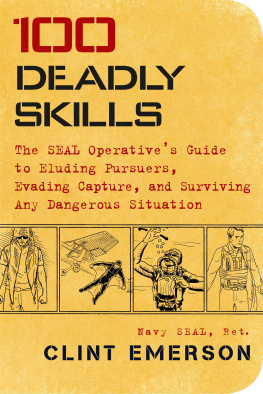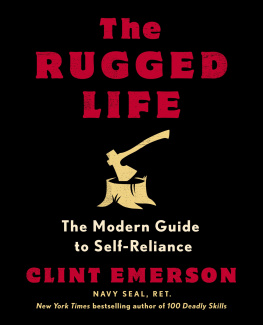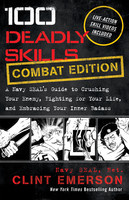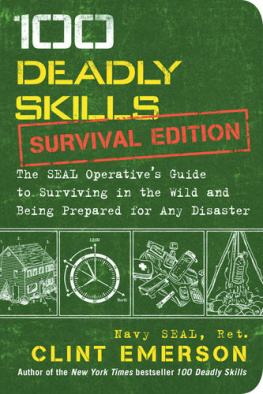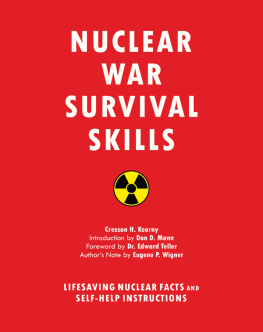CONTENTS
A Note to Readers
The skills described in the following pages are called deadly for a reasonand not just because of the danger they pose to others. Developed by highly trained operatives who regularly face life-threatening conditions, these skills push the limits of human endurance, precision, and ingenuity.
And often, the boundaries of the law.
The book you are holding in your hands (or reading on your device) contains actionable information adapted from the world of special operations. Much of that information, shared here with civilians in the spirit of self-defense, is to be used in only the direst emergencies.
When confronted with unexpected danger, in many cases the safest course of action is escape. In the face of an active shooter (see ), the first option (if conditions allow) is to runand the last is to fight. If a thief wants your valuables, hand them over. If the end of the world truly does come to pass... well, then all bets are off.
The author and publisher disclaim any liability from any injury that may result from the use, proper or improper, of the information contained in this book. The stated goal of this book is not to enable a deadly class of citizens but to entertain while simultaneously imparting a body of knowledge that may come in handy in the absolute direst of emergencies.
Be deadly in spirit, but not in action. Respect the rights of others and the laws of the land.
Our fate is determined by how far we are prepared to push ourselves to stay alivethe decisions we make to survive. We must do whatever it takes to endure and make it through alive.
BEAR GRYLLS
INTRODUCTION
Potential dangers lurk everywhere these days. Disasters strike in war-torn regions and far-flung locationsbut with alarming regularity, they also seem to inch closer and closer to home. Spanning acts of terror, mass shootings, and the unseen (and sometimes virtual) matrix of everyday crime, danger refuses to be confined to dark alleys, unstable nations, or distant zip codes.
People tend to imagine worst-case scenarios in highly colorful terms, but chaos and crime are the real apocalyptic scenarios. We picture aliens, frozen tundra, and intergalactic warfare, when in fact the catastrophic event weve been waiting for is more likely to look like a mundane report of vandalism on last nights newsor the massive Internet shutdown in tomorrows headlines. Or, indeed, the violent criminal hiding in the shadows of a desolate parking garage. In the face of true catastrophe, a basement full of canned peas and distilled water isnt likely to be much help.
In a future where every stranger poses a potential threat, knowing the predator mindset is the only safe haven. What are the tricks used by the stealthiest, most dangerous human beings in our midst? How can you spot and avoid the dangers that surround us? You could turn to the criminal class to find out. Or you could go one better by taking a page from some of the most highly trained specialists on the planet.
The one hundred deadly skills you are about to encounter are adapted from the world of special operations, a complex web of associations dominated by operatives with a shared predilection for intrigue and danger. These elite, highly skilled warriors are charged with risking their lives under the most challenging and dire conditions on earth. As operatives who routinely infiltrate the worlds most dangerous and volatile regions, they must be equal parts spies, soldiers, and lawless rule-breakers.
They are action heroes for modern times, one-part James Bond, the other Rambo. Some call these highly skilled operatives Violent Nomads, as a nod to their disregard for international borders and their bias for swift, brutal action.
Many of the techniques that make up the Violent Nomad body of knowledge cannot be divulged without severe risk to public safety, but a great deal of potentially lifesaving information can still be shared. Each skill is broken down into its most critical parts, or Courses of Action (COAs), and summed up by a BLUF (Bottom Line Up Front), which spells out the key takeaway from the operatives perspective; Civilian BLUFs flip the skills around and outline preventive measures civilians can take to arm themselves against predators using these particular techniques.
As a retired Navy SEAL who spent several years inside the NSA (National Security Agency), in writing this book I drew on an unusual breadth of experience that spans twenty years spent running special ops all over the world, both in teams and alone, and merges lessons learned from both combat and surveillance. The skills in this book represent a potential path to survival in the face of any number of dangerous situations, from eluding pursuers and escaping abduction to self-defense. And they may even provide a blueprint for getting through doomsday.
The world isnt getting any safer, but you can be prepared. Whether youre faced with an alien invasion or an assailant wielding a seemingly innocuous item such as a water bottle or an umbrella, learning how to think like a Violent Nomad will radically improve your chances of coming out on top.
PART I
MISSION PREP
Anatomy of a Violent Nomad
Beyond the defensive potential common to many of the skills in this book, there is much the average civilian can learn from an operatives mindset. First and foremost, that mindset is defined by preparedness and awareness. Whether in home territory or under deepest cover, operatives are continually scanning the general landscape for threats even when theyre not on the clock. Civilians, too, can train their minds toward habits such as scouting exit routes in crowded restaurants or building spur-of-the-moment escape plans. This kind of vigilance allows an operative confronted with sudden danger to take immediate action.
Whether he is crossing borders, executing surveillance, or eliminating dangerous targets and disappearing without a trace, the clandestine operative frequently works alone. Given that he so often finds himself behind enemy lines without reinforcements, an operatives combat and counterintelligence skills are met by an equally sophisticated aptitude for risk assessment and analysis. In an increasingly dangerous world, civilians who are attuned to potential risk (particularly but not exclusively when traveling) will be many steps ahead of the general populace.
The operative also demonstrates a baseline predisposition toward anonymity. Each clandestine operative is trained to go black, operating for extended periods of time with limited communication to associates. While operating under the radar, he may assume the outward appearance of a student, a businessperson, or a traveler, as he understands that terrorist groups or host-nation governments may be targeting him during his travelsand that if perceived as a spy and arrested, he will be subject to detention and harsh interrogations. Additionally, as a traveler, he is vulnerable to the risks of petty crime and kidnapping that apply to any civilian traveling abroad. To counter such risks, the operative adopts as neutral an appearance as possible. The general rule is the less conspicuous the Nomad, the safer.

Due to the highly covert nature of their missions, operatives go to great lengths to ensure that they blend into their surroundings. A carefully managed appearance allows them to operate undetected by potential witnesses as well as host-country police and security services. But beyond their unremarkability, clothing and gear must have the capability to conceal the equipment required for an operation or an escape. (The waistband and cuffs of pants and the tongues of shoes, for example, are ideal hiding places for handcuff keys and razor blades.)

